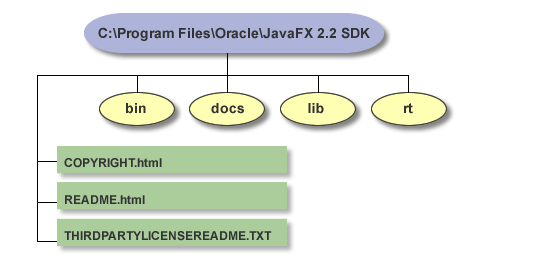JavaFX 2.2.5 Installation Guide
1 JavaFX 2.2.5 Installation for Microsoft Windows
This page provides information about the installing JavaFX 2.2.5 on Microsoft Windows, either bundled with JDK 7 or standaloine for use with JDK 6.
This page contains the following topics:
Download the JavaFX Installer that Meets Your Needs
How you install JavaFX depends on whether you can install JDK 7u11 (recommended) or need to use JDK 6.
|
Note: If you use JDK 6, you will not be able to take advantage of all the latest JavaFX features, such as the ability to package self-contained applications, as described in the JavaFX Deployment Guide. |
Install JDK 7 Bundled with JavaFX (Recommended)
JDK 7u11 includes the JavaFX 2.2.5 libraries. Go to the following location for download and installation information:
http://www.oracle.com/technetwork/java/javase/downloads/
|
Note: The JDK 7 installer does not uninstall JavaFX versions older than 2.2. If you wish to uninstall previous standalone versions, see Uninstalling the Standalone JavaFX SDK and Runtime. |
The JDK 7u11 installer installs the following components, in this order:
-
Java Development Kit (JDK), including the JavaFX SDK libraries
-
Java Runtime Environment (JRE), including JavaFX Runtime libraries
After installation, the JavaFX SDK and Runtime libraries are integrated into the JDK and JRE directory structure. For more information, see JDK and JRE File Structure at
http://docs.oracle.com/javase/7/docs/technotes/tools/windows/jdkfiles.html
This is a change from releases of JavaFX prior to JDK 7u6/JavaFX 2.2, which were installed in directories independent from the JDK.
Install Standalone JavaFX for JDK 6
If you need to continue to use JDK 6 on Windows, you can install a standalone version of JavaFX 2.2.5.
|
Note: The standalone JavaFX installer uninstalls any previous standalone version of JavaFX SDK and JavaFX Runtime. |
To download the installer, go to the JavaFX download page at
http://www.oracle.com/technetwork/java/javase/downloads/javafxjdk6-1728173.html
|
Note: There is a 32-bit or 64-bit JavaFX available. Use the bit version that matches that of your JDK installation. |
The default installation directories for standalone JavaFX installations are as follows:
-
JavaFX SDK: C:\Program Files\Oracle\JavaFX 2.2 SDK.
-
JavaFX Runtime: C:\Program Files\Oracle\JavaFX 2.2 Runtime
Standalone JavaFX SDK File Structure
The standalone JavaFX 2.2.5 SDK contains the directories and content shown in Figure 1-1.
- bin/
-
Contains the JavaFX Packager tool for compiling, packaging, signing, and deploying JavaFX applications.
- docs/
-
Contains the API documentation. For the online version of the API documentation and JavaFX tutorials, see
http://docs.oracle.com/javafx/ - lib/
-
Contains the following JavaFX utility jar files:
ant-javafx.jar: Ant tasks for packaging and deployment.
javafx-doclet.jar: A doclet for producing customized and nicely formatted documentation for the users of your JavaFX library.
javafx-mx.jar: A file used for debugging.
- rt/
-
Contains a private, embedded copy of the JavaFX Runtime installation, used by JavaFX SDK development tools. You would typically point to the installed JavaFX Runtime instead.
- COPYRIGHT.html
-
Copyright information for the JavaFX software and documentation.
- README.html
-
Provides a link to the README index page for the JDK, JavaFX SDK, JavaFX Runtime.
- THIRDPARTYLICENSEREADME.txt
-
License information for third-party software included in the JavaFX SDK.
After Installation
Uninstalling the Standalone JavaFX SDK and Runtime
To uninstall the standalone JavaFX SDK and JavaFX Runtime, use the standard Windows Add/Remove Programs utility in Control Panel. You must uninstall the JavaFX SDK and Runtime separately.
Note that for JavaFX 1.3.1 and earlier, you must uninstall using Java Control Panel. For more information about uninstalling standalone versions of JavaFX, see the JavaFX installation page at
http://www.java.com/en/download/help/javafx_install.xml


